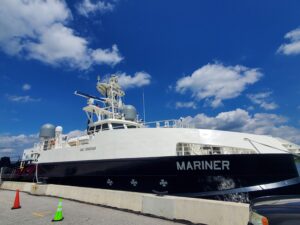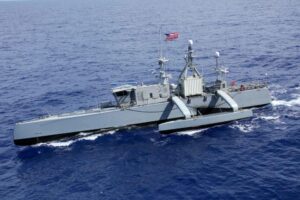Earlier this month the Chief of Naval Operations outlined how the Navy plans to get to the construction contract for the first Large Unmanned Surface Vehicles (LUSV) by fiscal year 2025.
“The [capabilities development document, CDD] is being developed right now to deliver in ‘23 that actually lays out the specific requirements for LUSV,” Adm. Mike Gilday told reporters during the Navy League’s annual Sea Air Space conference on April 4.

He added that “within two months, we’re doing land-based engineering testing” at commercial sites.
During a previous lunch speech, Gilday said the point of that testing “is to deliver a reliable engineering plan configuration for propulsion in both electrical power generation, so that eventually we have reliable systems to put on these unmanned vessels that, in accordance with the 2021 NDAA, operate at least 720 hours of continuous operations, or 30 days.”
He said the Navy plans to experiment with underway refueling of the LUSVs and Medium USVs (MUSVs), remote firing demonstrations and continued science and technology and research and development on them.
Gilday told reporters that first using the commercial land-based engineering testing, based on the CDD will allow the Navy to assess how to proceed next instead of standing it up now at Naval Surface Warfare Center, Philadelphia with a final engineering plant.
The testing will inform how the Navy will decide “how we’re going to put that engineering plan together and then make the investment in a land based test site up in Philly. We’ll run that engineering plant just like we’ve done with [Arleigh Burke-class destroyers], just like we intend to do with [Constellation-class frigates],” he said.
The CNO said this means the plan is to finish the CDD by the end of fiscal year (FY) 2023 land-based testing at the commercial sites beginning within two months and ending in FY ‘24, and then Navy selection of a potential procurement to build the LUSV by the end of FY ‘25.
According to the Navy’s FY ‘24 budget request, the budget delayed procurement of initial production LUSVs to FY 2025 “to align with risk reduction and qualification plans as described in the Program System Engineering Framework (Work Breakdown Structure (WBS)).”
The Navy has already established a Land Based Test Site at Naval Surface Warfare Center, Philadelphia to currently test ancillary equipment as well as develop and prove government-furnished engineering autonomy software and machinery control systems.
The budget lays out the Navy’s planned detail design and construction (DD&C) timeline for production of the initial vessel: a Request For Proposals by the second quarter of 2024, source selection from the third quarter of 2024 to third quarter of 2025, DD&C Milestone B reached by the third quarter of 2025, and an award by the fourth quarter of 2025.
In 2020 the Navy awarded HII [HII], Lockheed Martin [LMT], Fincantieri Marinette Marine, Bollinger Shipyards Lockport LLCS, Austal USA, and Gibbs & Cox Inc. firm-fixed price contracts with individual awards worth about $7 million each for initial work on LUSV studies that could increase up to $59 million (Defense Daily, Sept. 4, 2020).

Then, last August, the Navy awarded all six companies modifications worth over $61 million to continue the studies. If all options are exercised, the work may continue through September 2024 (Defense Daily, Aug. 5, 2022).
The LUSV is set to serve as an adjunct magazine that moves missiles a separate crewed ship will remotely launch as well as carry other sensing and non-kinetic weapon payloads.
Last month, Rear Adm. Fred Pyle, director of the Surface Warfare Division, N96, in the Office of the Chief of Naval Operations, said the Navy could look at ultimately adding Conventional Prompt Strike (CPS) system hypersonic missiles to LUSVs down the line (Defense Daily, March 3).
Pyle said after the CPS has its successful demonstrations many senior leaders like him will seek to proliferate CPS across their segments of the fleet.